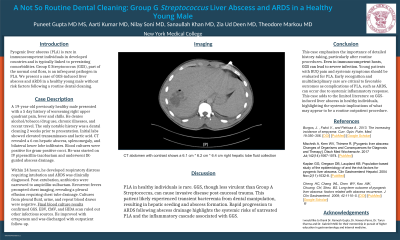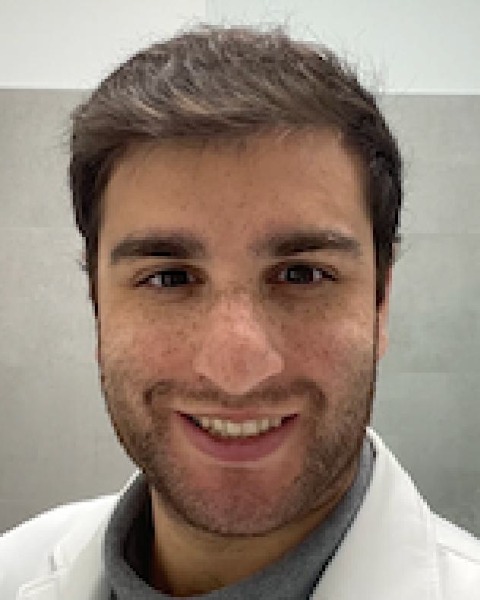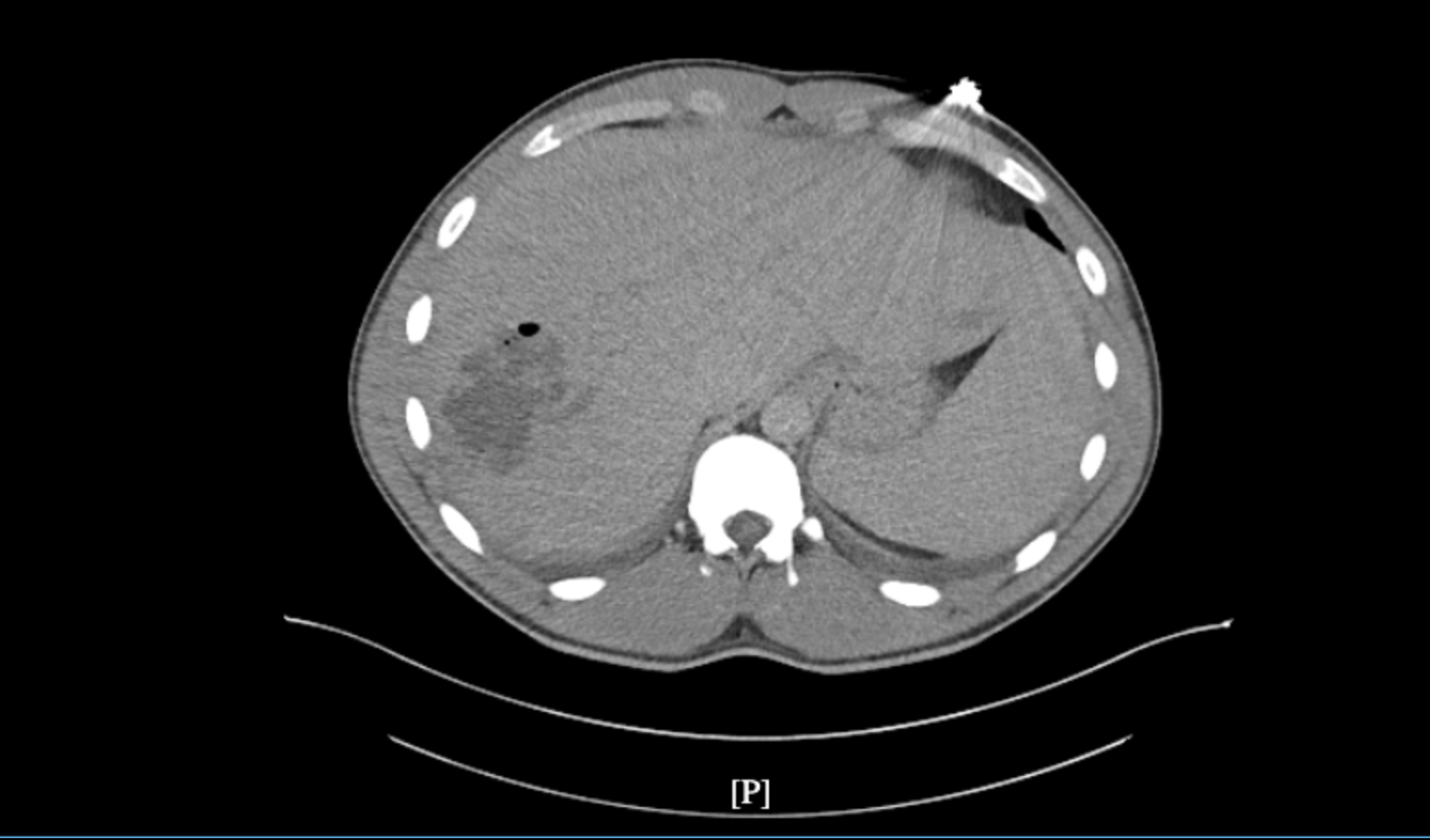Tuesday Poster Session
Category: Liver
P5983 - Liver Abscess and ARDS in a Healthy Young Male Following Routine Dental Cleaning: An Uncommon Sequelae of Group G Streptococcal bacteremia
Tuesday, October 28, 2025
10:30 AM - 4:00 PM PDT
Location: Exhibit Hall

Has Audio

Puneet Gupta, MD
Saint Clare's Health, New York Medical College
Franklin Lakes, NJ
Presenting Author(s)
Puneet Gupta, MD1, Sanaullah Khan, MD2, Aarti Kumar, MD3, Nilay Soni, MD2, Zia U. Deen, MD2, Theodore Markou, MD4
1Saint Clare's Health, New York Medical College, Franklin Lakes, NJ; 2Saint Clare's Health, New York Medical College, Denville, NJ; 3Internal Medicine Residency at St Mary's Hospital and St Clare's Health, New Jersey /New York medical College / Prime Healthcare, Passaic, NJ; 4Saint Clare's Health, New York Medical College, Randolph, NJ
Introduction: Pyogenic liver abscess (PLA) is rare in immunocompetent individuals in developed countries and is typically linked to preexisting comorbidities. Group G Streptococcus (GGS), part of the normal oral flora, is an infrequent pathogen in PLA. We present a case of GGS-induced liver abscess and ARDS in a healthy young male without risk factors following a routine dental cleaning.
Case Description/Methods: A 19-year-old previously healthy male presented with 5 days of worsening right upper quadrant pain, fever and chills. He denies alcohol/tobacco/drug use, chronic illnesses, and recent travel. The only notable history was a dental cleaning 2 weeks prior. Initial labs showed elevated transaminases and lactic acid. CT revealed a 6 cm hepatic abscess, splenomegaly, and bilateral lower lobe infiltrates. Blood cultures were positive for gram-positive cocci. He was started on IV piperacillin-tazobactam and underwent IR-guided abscess drainage. Within 24 hours, he developed respiratory distress requiring intubation and ARDS was clinically diagnosed. Post-extubation, antibiotics were narrowed to ampicillin-sulbactam. Recurrent fevers prompted chest imaging, revealing a pleural effusion requiring chest tube drainage. Cultures from pleural fluid, urine, and repeat blood draws were negative. Final blood culture results confirmed GGS. EBV, CMV, and HIDA scan ruled out other sources. He improved with ertapenem and was discharged with outpatient follow-up.
Discussion: PLA in healthy individuals is rare. GGS, though less virulent than Group A Streptococcus, can cause invasive disease post-mucosal trauma. This patient likely experienced transient bacteremia from dental manipulation, resulting in hepatic seeding and abscess formation. Rapid progression to ARDS post-drainage highlights the systemic risks of untreated PLA and the inflammatory cascade associated with GGS.
This case emphasizes the importance of detailed history-taking, particularly after routine procedures. Even in immunocompetent hosts, GGS can lead to severe infection. Young patients with RUQ pain and systemic symptoms should be evaluated for PLA. Early recognition and multidisciplinary care are critical to favorable outcomes as complications of PLA, such as ARDS, can occur due to systemic inflammatory response. This case adds to the limited literature on GGS-induced liver abscess in healthy individuals, highlighting the systemic implications of what may appear to be a routine outpatient procedure.

Disclosures:
Puneet Gupta, MD1, Sanaullah Khan, MD2, Aarti Kumar, MD3, Nilay Soni, MD2, Zia U. Deen, MD2, Theodore Markou, MD4. P5983 - Liver Abscess and ARDS in a Healthy Young Male Following Routine Dental Cleaning: An Uncommon Sequelae of Group G <i>Streptococcal bacteremia</i>, ACG 2025 Annual Scientific Meeting Abstracts. Phoenix, AZ: American College of Gastroenterology.
1Saint Clare's Health, New York Medical College, Franklin Lakes, NJ; 2Saint Clare's Health, New York Medical College, Denville, NJ; 3Internal Medicine Residency at St Mary's Hospital and St Clare's Health, New Jersey /New York medical College / Prime Healthcare, Passaic, NJ; 4Saint Clare's Health, New York Medical College, Randolph, NJ
Introduction: Pyogenic liver abscess (PLA) is rare in immunocompetent individuals in developed countries and is typically linked to preexisting comorbidities. Group G Streptococcus (GGS), part of the normal oral flora, is an infrequent pathogen in PLA. We present a case of GGS-induced liver abscess and ARDS in a healthy young male without risk factors following a routine dental cleaning.
Case Description/Methods: A 19-year-old previously healthy male presented with 5 days of worsening right upper quadrant pain, fever and chills. He denies alcohol/tobacco/drug use, chronic illnesses, and recent travel. The only notable history was a dental cleaning 2 weeks prior. Initial labs showed elevated transaminases and lactic acid. CT revealed a 6 cm hepatic abscess, splenomegaly, and bilateral lower lobe infiltrates. Blood cultures were positive for gram-positive cocci. He was started on IV piperacillin-tazobactam and underwent IR-guided abscess drainage. Within 24 hours, he developed respiratory distress requiring intubation and ARDS was clinically diagnosed. Post-extubation, antibiotics were narrowed to ampicillin-sulbactam. Recurrent fevers prompted chest imaging, revealing a pleural effusion requiring chest tube drainage. Cultures from pleural fluid, urine, and repeat blood draws were negative. Final blood culture results confirmed GGS. EBV, CMV, and HIDA scan ruled out other sources. He improved with ertapenem and was discharged with outpatient follow-up.
Discussion: PLA in healthy individuals is rare. GGS, though less virulent than Group A Streptococcus, can cause invasive disease post-mucosal trauma. This patient likely experienced transient bacteremia from dental manipulation, resulting in hepatic seeding and abscess formation. Rapid progression to ARDS post-drainage highlights the systemic risks of untreated PLA and the inflammatory cascade associated with GGS.
This case emphasizes the importance of detailed history-taking, particularly after routine procedures. Even in immunocompetent hosts, GGS can lead to severe infection. Young patients with RUQ pain and systemic symptoms should be evaluated for PLA. Early recognition and multidisciplinary care are critical to favorable outcomes as complications of PLA, such as ARDS, can occur due to systemic inflammatory response. This case adds to the limited literature on GGS-induced liver abscess in healthy individuals, highlighting the systemic implications of what may appear to be a routine outpatient procedure.

Figure: CT abdomen with contrast shows a 6.1 cm * 6.2 cm * 6.4 cm right hepatic lobe fluid collection
Disclosures:
Puneet Gupta indicated no relevant financial relationships.
Sanaullah Khan indicated no relevant financial relationships.
Aarti Kumar indicated no relevant financial relationships.
Nilay Soni indicated no relevant financial relationships.
Zia Deen indicated no relevant financial relationships.
Theodore Markou indicated no relevant financial relationships.
Puneet Gupta, MD1, Sanaullah Khan, MD2, Aarti Kumar, MD3, Nilay Soni, MD2, Zia U. Deen, MD2, Theodore Markou, MD4. P5983 - Liver Abscess and ARDS in a Healthy Young Male Following Routine Dental Cleaning: An Uncommon Sequelae of Group G <i>Streptococcal bacteremia</i>, ACG 2025 Annual Scientific Meeting Abstracts. Phoenix, AZ: American College of Gastroenterology.
